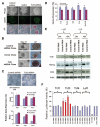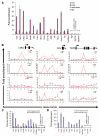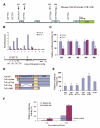T-cell factor 3 regulates embryonic stem cell pluripotency and self-renewal by the transcriptional control of multiple lineage pathways
- PMID: 18467660
- PMCID: PMC2692055
- DOI: 10.1634/stemcells.2007-1115
T-cell factor 3 regulates embryonic stem cell pluripotency and self-renewal by the transcriptional control of multiple lineage pathways
Abstract
The Wnt signaling pathway is necessary both for maintaining undifferentiated stem cells and for directing their differentiation. In mouse embryonic stem cells (ESCs), Wnt signaling preferentially maintains "stemness" under certain permissive conditions. T-cell factor 3 (Tcf3) is a component of the Wnt signaling and a dominant downstream effector in ESCs. Despite the wealth of knowledge regarding the importance of Wnt signaling underlying stem cells functions, the precise mechanistic explanation by which the effects are mediated is unknown. In this study, we identified new regulatory targets of Tcf3 using a whole-genome approach and found that Tcf3 transcriptionally represses many genes important for maintaining pluripotency and self-renewal, as well as those involved in lineage commitment and stem cell differentiation. This effect is in part mediated by the corepressors transducin-like enhancer of split 2 and C-terminal Binding Protein (CtBP). Notably, Tcf3 binds to and represses the Oct4 promoter, and this repressive effect requires both the Groucho and CtBP interacting domains of Tcf3. Interestingly, we find that in mouse preimplantation development embryos, Tcf3 expression is coregulated with Oct4 and Nanog and becomes localized to the inner cell mass of the blastocyst. These data demonstrate an important role for Tcf3 in modulating the appropriate level of gene transcription in ESCs and during embryonic development. Disclosure of potential conflicts of interest is found at the end of this article.
Figures







Similar articles
-
Tcf3 functions as a steady-state limiter of transcriptional programs of mouse embryonic stem cell self-renewal.Stem Cells. 2008 Aug;26(8):1951-60. doi: 10.1634/stemcells.2008-0229. Epub 2008 May 15. Stem Cells. 2008. PMID: 18483421 Free PMC article.
-
Tcf3 is an integral component of the core regulatory circuitry of embryonic stem cells.Genes Dev. 2008 Mar 15;22(6):746-55. doi: 10.1101/gad.1642408. Genes Dev. 2008. PMID: 18347094 Free PMC article.
-
Repression of Nanog gene transcription by Tcf3 limits embryonic stem cell self-renewal.Mol Cell Biol. 2006 Oct;26(20):7479-91. doi: 10.1128/MCB.00368-06. Epub 2006 Aug 7. Mol Cell Biol. 2006. PMID: 16894029 Free PMC article.
-
Maintaining embryonic stem cell pluripotency with Wnt signaling.Development. 2011 Oct;138(20):4341-50. doi: 10.1242/dev.066209. Epub 2011 Sep 8. Development. 2011. PMID: 21903672 Free PMC article. Review.
-
Role of Oct4 in maintaining and regaining stem cell pluripotency.Stem Cell Res Ther. 2010 Dec 14;1(5):39. doi: 10.1186/scrt39. Stem Cell Res Ther. 2010. PMID: 21156086 Free PMC article. Review.
Cited by
-
Pleiotropy of glycogen synthase kinase-3 inhibition by CHIR99021 promotes self-renewal of embryonic stem cells from refractory mouse strains.PLoS One. 2012;7(4):e35892. doi: 10.1371/journal.pone.0035892. Epub 2012 Apr 23. PLoS One. 2012. PMID: 22540008 Free PMC article.
-
Retinoic acid suppresses the canonical Wnt signaling pathway in embryonic stem cells and activates the noncanonical Wnt signaling pathway.Stem Cells. 2014 Aug;32(8):2061-71. doi: 10.1002/stem.1706. Stem Cells. 2014. PMID: 24648413 Free PMC article.
-
Small molecules for reprogramming and transdifferentiation.Cell Mol Life Sci. 2017 Oct;74(19):3553-3575. doi: 10.1007/s00018-017-2586-x. Epub 2017 Jul 11. Cell Mol Life Sci. 2017. PMID: 28698932 Free PMC article. Review.
-
Connecting microRNA genes to the core transcriptional regulatory circuitry of embryonic stem cells.Cell. 2008 Aug 8;134(3):521-33. doi: 10.1016/j.cell.2008.07.020. Cell. 2008. PMID: 18692474 Free PMC article.
-
Systems biology provides new insights into the molecular mechanisms that control the fate of embryonic stem cells.J Cell Physiol. 2012 Jan;227(1):27-34. doi: 10.1002/jcp.22721. J Cell Physiol. 2012. PMID: 21412766 Free PMC article. Review.
References
-
- Logan CY, Nusse R. The Wnt signaling pathway in development and disease. Annu Rev Cell Dev Biol. 2004;20:781–810. - PubMed
-
- Zechner D, Fujita Y, Hulsken J, et al. beta-Catenin signals regulate cell growth and the balance between progenitor cell expansion and differentiation in the nervous system. Dev Biol. 2003;258:406–418. - PubMed
-
- Hirabayashi Y, Itoh Y, Tabata H, et al. The Wnt/beta-catenin pathway directs neuronal differentiation of cortical neural precursor cells. Development. 2004;131:2791–2801. - PubMed
-
- Huelsken J, Vogel R, Erdmann B, et al. beta-Catenin controls hair follicle morphogenesis and stem cell differentiation in the skin. Cell. 2001;105:533–545. - PubMed
Publication types
MeSH terms
Substances
Grants and funding
LinkOut - more resources
Full Text Sources
Other Literature Sources
Molecular Biology Databases
Research Materials

